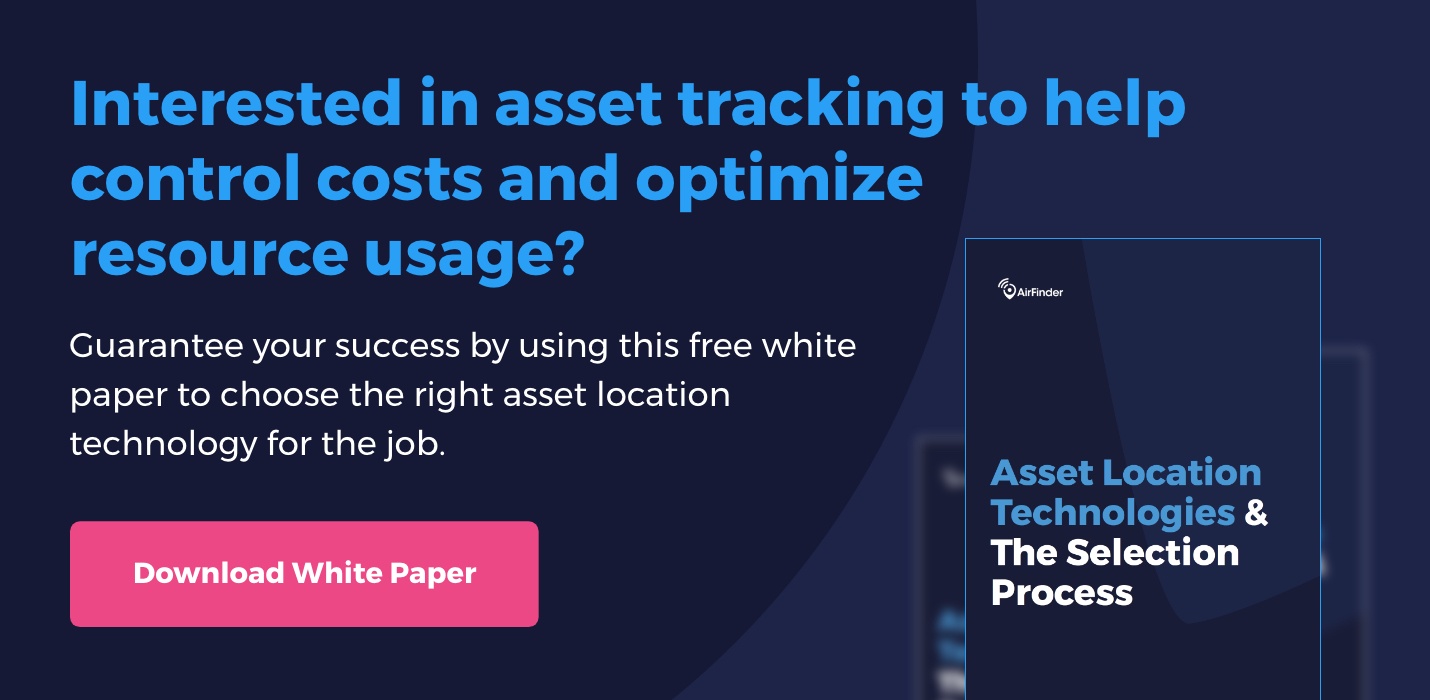Real-time location systems (RTLS) are becoming an increasingly more cost-effective approach for accurately tracking, locating, and monitoring all sorts of valuable business assets as they move from place to place.
So much so, in fact, that RTLS platforms have made their way into multiple industries - from manufacturing and construction, to healthcare, emergency management and hospitality. And if you’re wondering what it takes to successfully implement an RTLS solution, you’ve come to the right place.
To start with, RTLS solutions use a variety of location technologies, including - ultrasound, radio frequency identification (RFID), infrared, ultra-wideband (UWB), WiFi, and Bluetooth Low Energy (BLE). What’s more, most systems work off of a combination of these technologies, depending on the level of precision required for a particular application.
Additional reading: Asset Location Technologies & The Selection Process
So, before you make the big move, you should probably map out a solid implementation plan. And to give you a running start, here’s a fundamental blueprint for success, based on our years of experience developing affordable, reliable, and user-friendly RTLS software.
1) Flesh Out Your RTLS Business Case
As you undoubtedly know, successful investments deliver measurable business value - which is why it’s always a good idea to begin with a solid business case that clearly conveys the imminent need for and anticipated benefits of any proposed project.
So when it comes to adopting an RTLS platform, you will want to flesh out a business case, grounded in a “deep dive” analysis, which includes the following:
A Clearly Articulated Statement of Need
Identify the problem(s) you might readily solve with an RTLS, using data, wherever possible, to make your case. For example, the amount of valuable resources and precious time your company expends looking for essential assets when you need them. Or the escalating cost of replacing lost, stolen, or broken assets.
You might also use specific examples to convey the positive impact a system like this could have on employee safety, customer service and/or regulatory compliance.
SMART Goals for Achieving Positive Financial Outcomes
As with any technology investment of this scope, it’s important to aim for a healthy financial return. That will mean identifying a set of SMART (specific, measureable, attainable, relevant and time-bound) goals to help you get there.
In creating these goals, be sure to consider both the tangible quantitative outcomes - the return on investment (ROI) - as well as the more intangible, qualitative outcomes - the value on investment (VOI). For example, the savings accrued from reducing asset loss by 75% over 12 months will increase your ROI; whereas enhancing productivity and process efficiency will go into the VOI column.
Key Performance Indicators (KPIs)
In tracking your progress toward meeting your goals, you will also need to establish the key performance indicators, with which to measure success. Likewise, identify baseline metrics for each KPI, to use in calculating any significant improvement after implementing your new asset location system.
Anticipated Changes in Business Needs Post-Implementation
No doubt about it. Business needs change over time - which is why you will want to ensure that your asset tracking solution can, in fact, evolve to accommodate that change.
Let’s say that your strategic growth and development plan calls for doubling your warehouse space over the next two years or streamlining certain IT systems. That’s important information to have in selecting a right-fit solution - like AirFinder RTLS - that can be scaled to meet your criteria for accuracy, visibility and cost of ownership, over time.
A List of Existing IT Systems
Every business has existing IT systems that are essential to their operation - for example, accounting or warehouse management software - many of which must be integrated with your new RTLS. So your business case should include a list of key systems already in place, department by department, to use in selecting an RTLS that works well with your current IT infrastructure.
2) Identify Your Stakeholders and Bring Them to the Table
The human brain is actually hardwired to resist change - which is why we have such a hard time incorporating changes in our routines, despite any benefits we might realize from them.
And let’s face it, enterprise-wide projects like an RTLS solution implementation, will require plenty of changes to systems, processes, and job responsibilities.
That’s where stakeholder buy-in comes in. By ensuring that everyone with a stake in the outcome - from design to launch to full implementation - has an opportunity to weigh in on the new system, you will allay a good bit of the inevitable resistance on the front end.
Of course, you are probably wondering how that can possibly happen in a company with hundreds or thousands of employees. Well, the answer is simple. Start by bringing the executives, department heads, team leads, and IT managers to the table, with the goal of empowering them to educate the rest of your workforce.
Think of these key stakeholders as your RTLS project “working group,” assembled to provide their input and feedback on such issues as how the proposed solution will affect company culture and its impact on both individual jobs and whole departments.
Be sure to highlight specific benefits and financial gains you hope to achieve, while citing success stories from other similar businesses.
Likewise, take the time to brainstorm and create a set of use cases (or kinds of problems to solve), based on the number and type of assets to track, where, to what degree, and at what scale over time. And let them know that you will need their expertise after the initial launch, to manage the implementation process, evaluate ongoing progress, and ideate new use cases based on changing needs, going forward.
3) Select a Right Fit Solution Partner
The bottom line to any successful RTLS implementation lies in choosing a right fit solution partner - a trusted provider with a proven track record. One that understands your unique business requirements and is invested in coming up with an effective solution (not simply selling you something off the shelf).
A good partner also furnishes end-user training and responsive support, and is willing and able to accommodate your needs as they evolve. To kick start the process, you will want to appoint a selection team from within your stakeholder group, which includes the head of your IT department.
Have this team conduct initial research around both potential RTLS technologies and possible solution partners, based on the business and use cases you have developed. Use this research to create a prioritized list of qualified providers and begin interviewing those that make the top of the list.
4) Think Big, Start Small, and Scale As You Go
As with any technology solution, there will be glitches along the journey to full implementation, regardless of careful planning on your part. So while it’s important to map out the “big picture rollout,” you will want to work with your solution partner to gradually operationalize your plan in phases, using a process like the Stage Gate model.
Starting small will reduce your risk, while effectively managing your investment by having more time to 1) ensure you have the right partner, 2) prove the concept among your workforce; 3) gain real world experience with which to identify and fix any glitches, and 4) figure out when and how to appropriately scale the system.
5) Make Sure That All of Your End Users Are Properly Trained in the RTLS Solution
As we said earlier, implementing a new technology solution is always going to mean big change for end-users, at least a few of whom will be resistant to some extent. On top of that, there will be a learning curve as these users get up and running on the ins and outs of that solution, particularly when it comes to navigating inevitable “glitches.”
Thus, to maximize both your return and your value on investment, make sure that everyone involved in the rollout receives appropriate training and backend support in using and evaluating the RTLS (both of which a good solution partner will furnish).
6) Establish a Process for Evaluating an RTLS
Successful implementation is not a one-off process. It requires continuous evaluation to ensure that your RTLS is meeting your targets for both return and value on investment.
What’s more, a regular review process will enable you to collect the data you need to scale as you go, while pinpointing opportunities for improvement, as well as changing needs, over time. And perhaps most importantly, ongoing transparency will encourage greater support among everyone in the organization around the concept of asset visibility.
Begin by designating an evaluation committee from within your stakeholder working group, along with a formal review schedule based on identified KPIs. And after each assessment time point, have the committee generate a status update that can be distributed through the company’s internal communications system.
This report should summarize progress made toward meeting project goals, as well as identify areas for improvement, along with steps being taken to address them. This approach will also give you a way to document lessons learned along the rollout journey, which can be captured in regular project reports to the senior leadership team.
In Conclusion…
While successfully implementing an RTLS solution offers more than a few compelling benefits, it is not a simple process - and it certainly doesn’t happen in a vacuum. Which is why it’s essential to work with a solution partner that is not only expert at what they do, but will also put your unique needs front and center.
As a company dedicated to developing real-time location systems with real-world application, we recognize the importance of a strong working partnership that results in a first-rate customer experience. In fact, our clients choose us for any number of reasons - from responsive service and system simplicity, to innovative design and affordability.
So as you begin the planning process, know that we are always here to answer questions or provide recommendations...either onsite or over the phone.





